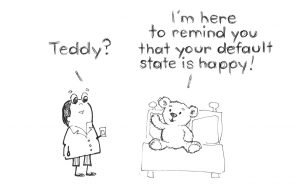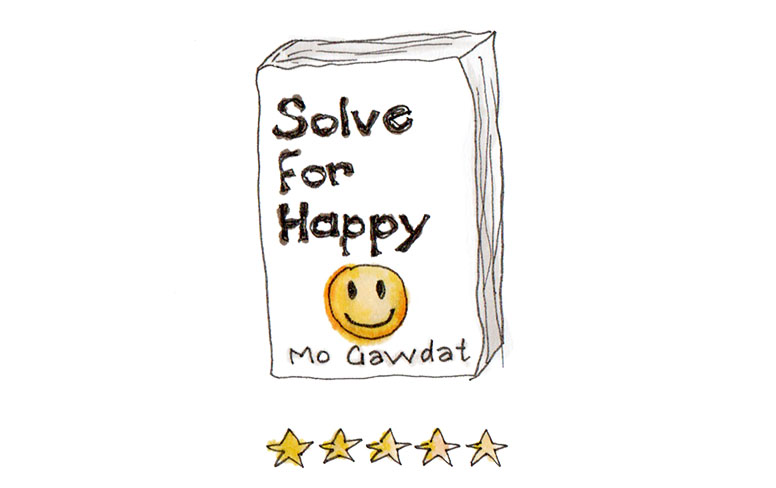My friend Rose very kindly sent me the book “Solve for Happy“. It’s about engineering your path to joy written by Mo Gawdat, the the chief business officer at Google X. He is an engineer so he approaches the problem with the engineering methodology of breaking down the problem into components, analysing the data, applying logic and financial finding trends then determining a formula that will yield a consistent solution. Sounds a bit odd or coldhearted perhaps when you’re talking about finding joy but his points are incredibly good and practical. And most impressively Mo is able to apply his solution when he himself tragically loses his own son.
At the start of the book, Mo Gawdat makes one of the best suggestions. He says to write yourself what he calls a Happy List. His point, and I found this myself what I wrote my own list, is that we tend to think of happiness as something really big, difficult or elusive; you know something that only happens way in the future. What I found to be true is that the things that do make me happy tend to be just the little things, every day things. It’s true that’s where I find my joy. It’s the little things like chatting with my best friend Monica, brushing my horse’s tail after I’ve washed it, writing in my journal, drawing cartoons, or getting a card in the post from my mum. It was actually one of the best things about writing a Happy List is what Mo points out – you cultivate happiness by being grateful. So I think that was my first lesson: slow down, take notice and be grateful for the little things. I think this is where journalling comes in and for me also drawing obviously; both work because they make me slowdown, take notice and well with joy digest something. Everything seems better then.
Naturally being an engineer, Mo has a formula for happiness; we are happy when our perception of events minus our expectations of how things should be, turns out to be a positive number. In other words it’s our thinking that makes us unhappy: when we were expecting something to be better than it seems according to our perceptions. The point is, it’s our thoughts that make us suffer. The event is just an event. I find this so true. It’s all a matter how you see things through your own filter. And his point about it’s your thoughts that make us suffer, means.. then it’s our thoughts that we need to address. Happiness is a choice. A conscious choice. I like this. It’s good news because if it’s a conscious choice then there is something that I can do about it. It’s not about what has happened to me; it’s about how I see things. Okay so now I know I can be happy. Now I just need to implement Mo’s methods. I can see there will be some (more) journalling involved here.
Oh. I almost forgot one other key point. This idea, I love. It’s so simple. It took me a bit to wrap my head around this idea. It’s so simple. Mo says happiness is our default state. Huh? We are born happy. Before we are self-aware, as long as our basic needs are met, we are happy. It’s true! This is such good news. Because it means again it’s just thinking that makes us unhappy. This is the proof! And as an engineer I love a proof! Maybe I have more of an engineering mind then I originally thought. The other good thing is there’s really nothing that I need to add in order to be happy. In fact all I need to do is subtract suffering. Simple maths.
One of the best points is when Mo says “true joy is to be in harmony with life exactly as it is”. I like that. It reminds me of another quote I used to repeat myself all the time; “I will not fight with my life, I will balance with it”.
Then Mo gets into techniques to help you change your mind. It’s a pretty simple concept – your brain can’t multitask. It can only think of one thing at a time. So the good news being, you can intervene by directing your attention outside of your mind. He says he sometimes simply tells his brain “I want you to shut up now”. Then once you can get outside of your mind you’ll be happy. Thinking about it, this is great because my thoughts can be so negative and self critical. If those thoughts are just noise in my mind, and I’m not those thoughts, well what a relief.
Another great strategy I think I’ll apply when I get off track is what he terms the permanence test. So basically if a quality or event that I associate myself with can change when I otherwise remain the same then by definition quality isn’t me. That’s also a big relief! Mo Talks about this in relation to the rules and masks that we wear; our ego.
Then interestingly, he talks about when he lost his son and how tempted he was to play the role of the grieving parent. He had been so used to having the role of father, that when his son died it was so tempting to allow him self to suffer. Maybe he felt obliged to suffer? But what he says is, ‘my son was never mine’. He was his. My interpretation of this is that it’s our ego that lets us feel possessive when really we don’t own anything. And it’s this ego with its attachments, that when we lose those attachments, we suffer loss. And it’s the loss of something that we never really had.
For me the other part of the book that really hit home and relates to this, was where he talks about the illusion of knowledge. I’ve always been so driven to learn and know as much as possible so that I could be right and be helpful. But as he points out, that’s an impossible task. Our senses are limited. Our perceptions are limited. Words are limited. When I thought about this this is actually rather reassuring. It takes the pressure off because I can never be that. For me that’s the best lesson in being happy; I can take the pressure off myself and just enjoy the journey of endlessly learning.
I hope you’ve enjoyed this book review. There’s a lot more to tell as you can imagine. I hope this is giving you a bit of inspiration to read this book And find your own path to Solve for Happy.
You can also learn more on Mo’s website about his journey to Happy.

Solve for Happy book review


I know this is a long time after the event, but that’s a lovely review. Thank you.